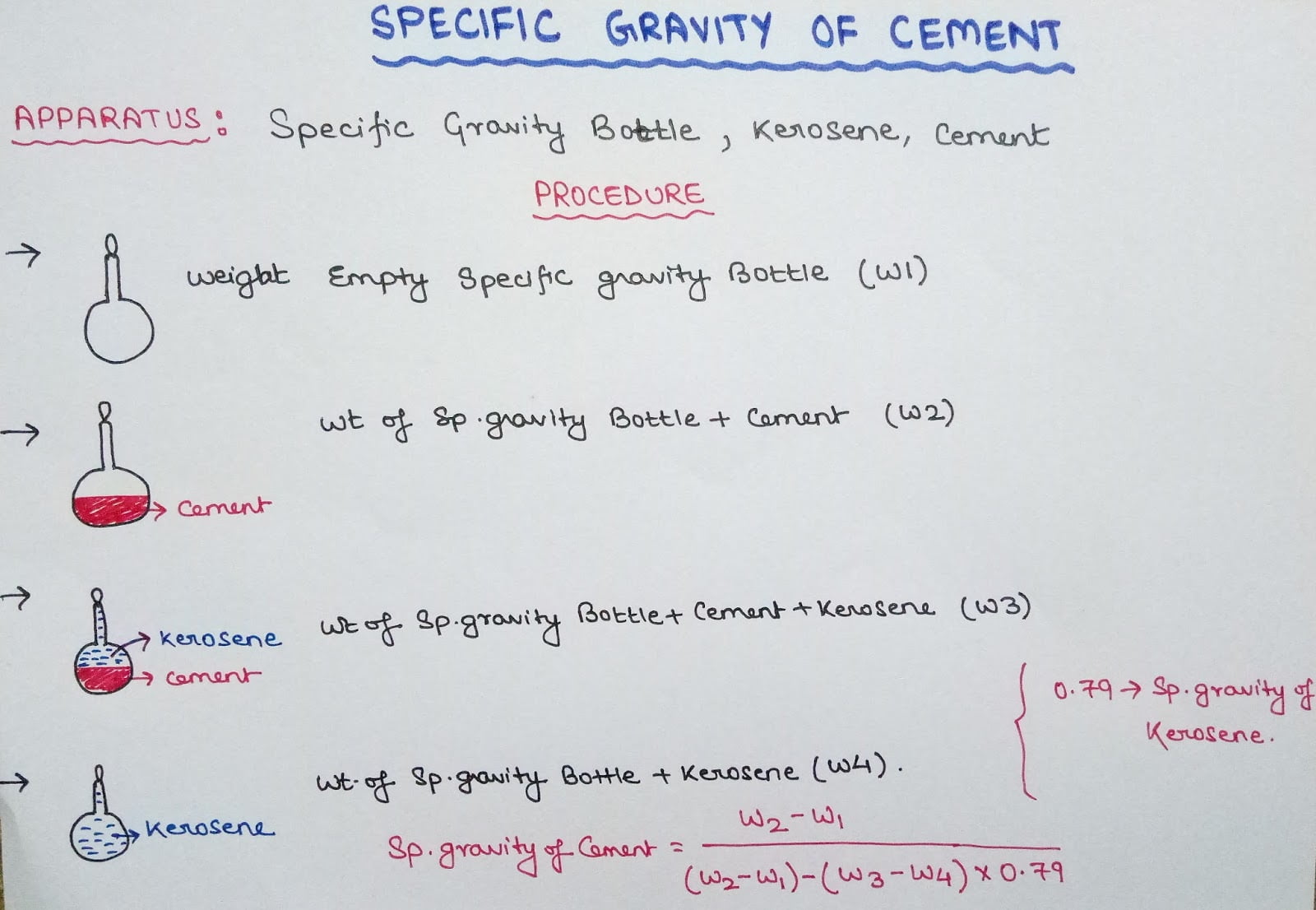Table of Contents
1. Introduction
Cement can be defined as the binding material having both cohesive and adhesive properties thereby capable of bonding the mineral fragments into a compact mass. One of the essential properties of cement is the specific gravity of cement.
The specific gravity of cement can be defined as the ratio of the density or the mass of cement to the density or the mass of reference material.

Specific gravity is an important indicator that defines how much heavier a substance is than water or any reference material of the same volume.
It is necessary to determine the specific gravity to ascertain the suitability of cement for a particular work.
The specific gravity of cement can be determined by Le Chatelier’s Flask method.
2. Standard Value of Specific Gravity of Cement
According to the Portland Cement Association (PCA), Design and Control of Concrete Mixtures, 1988, the specific gravity of the Ordinary Portland Cement is approximately equal to 3.15.
While the specific gravity value of the Portland Pozzolana cement is around 2.90.
3. Reference Material For Specific Gravity Determination of Cement
The reference material that is used for the specific gravity determination of cement is Kerosene.
The reason behind the use of kerosene as the reference material is that kerosene does not undergo any reaction when added to cement unlike water ( when water is added to cement, hydration occurs).
The specific gravity of the kerosene is 0.79.
4. Importance of Determining Specific Gravity of Cement
The specific gravity of cement depends upon the moisture content. This is because the cement particles essentially constitute pores that contain water within them.
In general practice, cement with a specific gravity of 3.15 is used for the nominal mix preparation.
When this value of specific gravity of the cement is changed, subsequently the mix design is also altered. Thus, it is of utmost necessity to determine the specific gravity of cement before it is mixed.
During bad weather conditions or extreme moisture content conditions, the specific gravity of cement can reach as high as 3.19. In such a case, the pores of the cement get filled with moisture and eventually undergo hydration. This makes the cement unsuitable for further use.
5. Test Procedure of Determining Specific Gravity of Cement
The specific gravity of cement is determined by the Le-Chatelier’s Flask Method which is briefly described below.
i. Apparatus & Equipment Required
a. Le-Chatelier’s Flask:
The Le-Chatelier’s flask consists of thin glass with a bulb at the bottom. The bulb has a mean diameter of 7.8cm and a capacity of 250ml.
The stem of the flask consists of graduations in millimeters.
At 8.8cm from the top of the bulb, zero graduation is present. Another bulb is present at 2cm from the zero graduation.
The length of this bulb is 3.5cm and has a capacity of 17ml.
At 1cm from the bulb, the stem of the flask is marked with 18 ml and is grated up to 24 ml.
The portion above this 24ml mark is in the form of a funnel having a diameter of 5cm.
b. Weighing Balance with an accuracy of 0.1gm.
c. Kerosene which is free from water.
d. Cement
ii. Procedure
The test procedure for determining the specific gravity of cement consists of the following series of steps:
a. First of all, Le Chatelier’s flask is taken and cleaned. It is then allowed to dry such that it does not contain any traces of liquid as well as moisture.
b. The dried empty flask is then weighed. Let the weight be denoted as W1.
c. Then, around 50gm of the cement is taken and filled in the bottle up to half of the bottle. The bottle is closed by means of a stopper.
d. The weight of the cement-filled bottle along with the stopper is then weighed. Let the weight recorded be denoted as W2.
e. Then, kerosene is added to the upper top portion of the flask. It must be mixed thoroughly such that no air bubbles are present.
f. The arrangement of the flask with the cement, kerosene, and the stopper is then weighed. Let the weight recorded be denoted as W3.
g. The entire flask is then emptied and again filled with kerosene on the top. Then, it is again weighed. Let the weight of the arrangement be denoted as W4.
iii. Observations & Calculations
The specific gravity of cement is calculated using the following formula:

iv. Precautions
a. The flask must be held at the same constant temperature before each reading is taken so that an accurate result is obtained.
b. The duplicate determination of the specific gravity must range within 0.01.
| Read More: Curing of Concrete |
| Read More: Uses of Cement |

